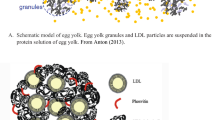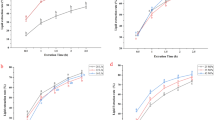Abstract
The vitelline membrane (VM) encloses the chicken egg yolk, separating it from albumen. The VM weakens during storage, and dietary lipid modification significantly affects its strength. However, no studies have characterize the fatty acyl residue (FA) composition of the VM, and reports of VM isolation and quantified lipid content are inconsistent. Therefore, the objectives of this study were: (1) to develop a washing and isolation method that removes residual yolk from VM without damage; (2) to determine the FA and lipid composition of CLA-rich egg yolk VM, relative to controls; (3) to determine the effect of 20 days of refrigeration on VM FA and lipid composition. To determine VM FA and lipid composition, 36 hens received either a corn-soybean meal-based control diet (“Control”), or the Control supplemented with either 10 % soy oil (“Soy control”), or 10 % CLA-rich soy oil (“CLA”) for 30 days. VM were analyzed the day of collection (“fresh”), or after 20 days of refrigeration (“refrigerated”). There were no differences in FA compositions of fresh and refrigerated membranes within a treatment. CLA-rich yolk VM contains CLA, greater SFA, and significantly greater DHA relative to controls. Direct MALDI-TOF–MS identified 15 phosphatidylcholines, three phosphatidylethanolamines, one sphingomyelin, and 15 triacylglycerols in VM. Lipid species that showed significant differences among egg types included nine phosphatidylcholines and six triacylglycerols. MALDI analysis indicated significant differences in nine lipid classes on the VM inner layer. After refrigeration, five lipid classes on the inner layer and seven lipid classes on the outer layer had statistically significant differences among VM types.



Similar content being viewed by others
Abbreviations
- CLA:
-
Conjugated linoleic acid
- d:
-
Days
- FA:
-
Fatty acyl residue
- FAME:
-
Fatty acid methyl ester
- GC-FID:
-
Gas chromatography-flame ionization detector
- MALDI-TOF MS:
-
Matrix-assisted laser desorption ionization time of flight mass spectrometry
- MUFA:
-
Monounsaturated fatty acyl residue
- PUFA:
-
Polyunsaturated fatty acyl residue
- SFA:
-
Saturated fatty acyl residue
- VM:
-
Vitelline membrane
References
Kido S, Doi Y (1988) Separation and properties of the inner and outer layers of the vitelline membrane of hens eggs. Poult Sci 67:476–486
Bellairs R, Harkness M, Harkness RD (1963) The vitelline membrane of the hen’s egg: a chemical and electron microscopical study. J Ultrastruct Res 8:339–359
St. John JL, Flor IH (1931) A study of whipping and coagulation of eggs of varying quality. Poult Sci 10:71–74
Trziszka T, Smolińska T (1982) Chemical characterization of the vitelline membrane of hens eggs. Food Chem 8:61–70
Mann K (2008) Proteomic analysis of the chicken egg vitelline membrane. Proteomics 8:2322–2332
Cunningham FE, Ylander DM (1980) Ultrastructure of vitelline membranes from normal and mottled egg yolks. Pout Sci 59:2449–2455
Nielsen SS (ed) (2010) Food analysis. Springer, New York, p 550
Fromm D (1967) Some physical and chemical changes in the vitelline membrane of the hens egg during storage. J Food Sci 32:52–56
Kelley AJ (2004) The effects of storage time on vitelline membrane protein banding patterns and interior egg quality of eggs from non-molted and molted hens. Doctoral Dissertation, Texas A&M University
Sharp PF, Powell CK (1930) Decrease in interior quality of hens eggs during storage as indicated by the yolk. Indust Eng Chem 22:908–910
Dunn-Hurrocks S, Pichardo-Fuchs M, Lee J, Ruiz-Feria C, Creger C, Hyatt D, Farnell M (2011) Effect of omega-3 enriched layer rations on egg quality Int J. Poult Sci 10:8–11
Shinn SE, Gilley AD, Proctor A, Anthony NB (2015) Effect of trans, trans CLA egg enrichment from CLA-rich soy oil on yolk fatty acid composition, viscosity and physical properties. J Agric Food Chem 63:2506–2513
Ahn DU, Sell JL, Jo C, Chamruspollert M, Jeffrey M (1999) Effect of dietary conjugated linoleic acid on the quality characteristics of chicken eggs during refrigerated storage. Poult Sci 78:922–928
Rohner TC, Staab D, Stoeckli M (2005) MALDI mass spectrometric imaging of biological tissue sections. Mech Ageing Dev 126:177–185
Shinn S, Liyanage R, Lay J, Proctor A (2014) Improved fatty acid analysis of conjugated linoleic acid rich egg yolk triacylglycerols and phospholipid Species. J Agric Food Chem 62:6608–6615
Jain VP, Proctor A, Lall R (2008) Pilot-scale production of conjugated linoleic acid-rich soy oil by photoirradiation. J Food Sci 73:E183–E192
NRC (1994) Nutrient requirements of poultry. Ninth Revised Edition, 1994. National Academy Press, Washington DC
Chamruspollert M, Sell JL (1999) Transfer of dietary conjugated linoleic acid to egg yolks of chickens. Poult Sci 78:1138–1150
Shinn SE, Gilley AD, Proctor A, Anthony NB (2015) Three hen strains fed photoisomerized trans, trans CLA-rich soy oil exhibit different yolk accumulation rates and source-specific isomer deposition. Lipids 50:397–406
Folch J, Lees M, Sloane-Stanley GH (1957) A simple method for the isolation and purification of total lipids from animal tissues. J Biol Chem 226:497–509
Lall RK, Proctor A, Jain VP (2009) A rapid, micro FAME preparation method for vegetable oil fatty acid analysis by gas chromatography. J Am Oil Chem Soc 86:309–314
Shah U, Proctor A, Lay JO Jr, Moon K (2012) Determination of CLA trans, trans positional isomerism in CLA-rich soy oil by GC–MS and silver ion HPLC. J Am Oil Chem Soc 89:979–985
Fuchs B, Schiller J, Süß R, Schürenberg M, Suckau D (2007) A direct and simple method of coupling matrix-assisted laser desorption and ionization time-of-flight mass spectrometry (MALDI-TOF MS) to thin-layer chromatography (TLC) for the analysis of phospholipids from egg yolk. Anal Bioanal Chem 389:827–834
Bourre JM (2005) Where to find omega-3 fatty acids and how feeding animals with diet enriched in omega-3 fatty acids to increase nutritional value of derived products for human: what is actually useful? J Nutr Health Aging 10:5
Ntambi JM, Choi Y, Park Y, Peters JM, Pariza MW (2002) Effects of conjugated linoleic acid (CLA) on immune responses, body composition and stearoyl-CoA desaturase. Can J Appl Physiol 27:617–627
Smolińska T, Trziszka T (1982) The vitelline membrane: dynamics of cholesterol metabolism in hens eggs. Food Chem 8:215–223
Acknowledgments
The authors greatly appreciate the use of Arkansas Nano and Bio Materials Characterization Facility at the University of Arkansas, supported by the National Science Foundation and the State of Arkansas.
Author information
Authors and Affiliations
Corresponding author
About this article
Cite this article
Shinn, S.E., Liyanage, R., Lay, J.O. et al. Isolation and Characterization of Chicken Yolk Vitelline Membrane Lipids Using Eggs Enriched With Conjugated Linoleic Acid. Lipids 51, 769–779 (2016). https://doi.org/10.1007/s11745-016-4153-x
Received:
Accepted:
Published:
Issue Date:
DOI: https://doi.org/10.1007/s11745-016-4153-x




